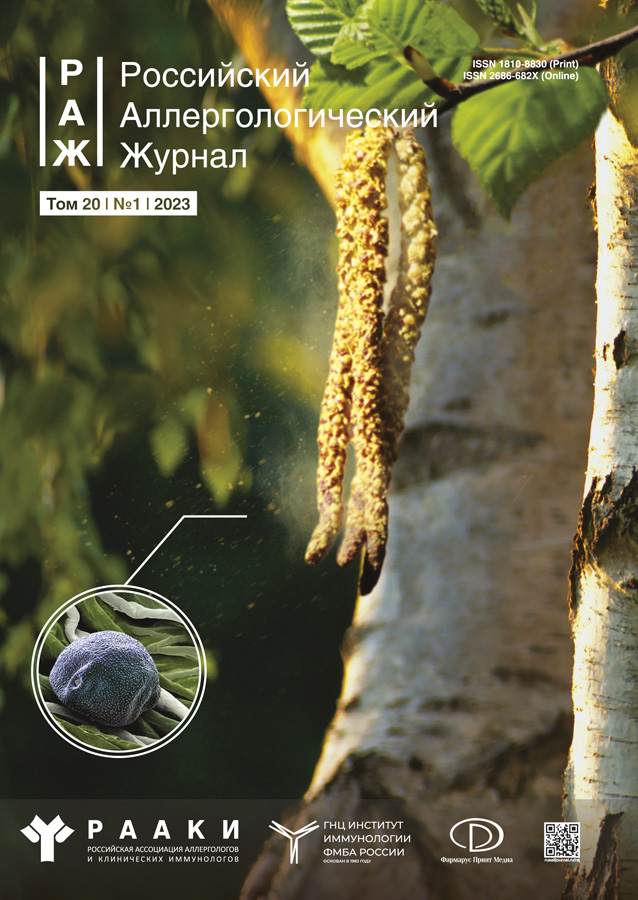Tablet-lyophilizate containing a mixture of house dust mites usage for skin prick testing to confirm house dust mites sensitization
- Authors: Nazarova E.V.1, Primak A.S.1
-
Affiliations:
- National Research Center ― Institute of Immunology
- Issue: Vol 20, No 1 (2023)
- Pages: 9-18
- Section: Original studies
- URL: https://journals.rcsi.science/raj/article/view/133018
- DOI: https://doi.org/10.36691/RJA3911
- ID: 133018
Cite item
Full Text
Abstract
BACKGROUND: Since 2021, the production of water-salt allergens for skin allergy tests with household allergens has been suspended, which has led to the lack of an objective opportunity for skin prick tests in medical and preventive institutions in the Russian Federation. Quantitative determination of allergen-specific immunoglobulin class E in the blood serum by the ImmunoCAP method is currently difficult because of the lack of supplies in the laboratory.
AIMS: To assess the possibility of using a drug solution of a lyophilizate mixture of house dust mites (Acarisax®) containing house dust allergens Dermatophagoides pteronyssinus and Dermatophagoides farinae in equal amounts —12 SQ-HDM — for the skin hood tests to confirm the sensitization of patients with mites of home dusts.
MATERIALS AND METHODS: Skin prick tests were conducted with dilutions of one tablet per 2.5 and 5 mL of diluting liquid of the study drug with positive and negative controls. Statistical analysis was conducted using Statistica 13.3 or IBM SPSS 17.0. To analyze efficacy and safety, standard parametric tests were used: Student’s t-test for dependent/independent samples, analysis of variance for repeated measurements, Mann–Whitney U-test, and Shapiro–Wilk test. The analysis of AEs was based on an estimate of the frequency of undesirable phenomena/serious undesirable phenomena.
RESULTS: The correlation was estimated between the total level of specific IgE to tick-borne allergens D. pteronyssinus and D. farinae measured during screening and the papule size 20 min after applying the drug in breeding with one tablet per 2.5 mL and 5 mL of a diluting liquid. The correlation coefficients (R) in both groups (total) were 0.735 (high correlation) and 0.762 (high correlation). The result was statistically significant (p <0.05) in both groups. The clinical test showed that the lyophilizate drug, a mixture of domestic dust mites containing dermal dust allergens D. pteronyssinus and D. farinae in equal quantities — 12 SQ-HDM — is a safe and informative method when used in skin hood tests to confirm the sensitization of patients to domestic dust ticks.
CONCLUSIONS: For skin hood tests, to confirm the sensitization of patients to domestic dust ticks, the studied drug can be used in greater dilution — one tablet per 5 mL of the diluting fluid. The lyophilizate mixture of dust mites containing D. pteronyssinus and D. farinae homemade allergens — 12 SQ-HDM — is safe and well tolerated by patients when used in skin test tests.
Full Text
##article.viewOnOriginalSite##About the authors
Evgeniya V. Nazarova
National Research Center ― Institute of Immunology
Author for correspondence.
Email: ev.nazarova@nrcii.ru
ORCID iD: 0000-0003-0380-6205
SPIN-code: 4788-7407
MD, Cand. Sci. (Med.)
Russian Federation, MoscowAnastasia S. Primak
National Research Center ― Institute of Immunology
Email: soulcreek.94@mail.ru
ORCID iD: 0000-0003-1309-5101
SPIN-code: 6171-7091
Russian Federation, Moscow
References
- Custovic А, Simpson А. The role of inhalant allergens in allergic airways disease. J Investig Allergol Clin Immunol. 2012;22(6): 393–401; qiuz follow 401.
- Korovkina ES, Mokronosova MA. Allergy to house dust mites from the standpoint of molecular allergology. Med Immunol. 2012;14(4-5):280–282. (In Russ). doi: 10.15789/1563-0625-2012-4-5-279-288
- Petrova SY, Khlgatyan SV, Berzhets VM. The house dust mites significance in the development of atopy. Russian Journal of Allergy. 2018;15(3):30–34. (In Russ).
- Drobik OS, Nasunova AY. House dust mites--invisible factors of visible problems. Modern approaches to tick allergy therapy. Med Adv. 2013;(7):59–65. (In Russ).
- Matsumura Y. Role of allergen source-derived proteases in sensitization via airway epithelial cells. J Allergy (Cairo). 2012;(2012):903659. doi: 10.1155/2012/903659
- Grishchenko EA. Dendritic cells of the respiratory tract and allergic diseases. Allergol Immunol Pediatr. 2015;(3):19–28. (In Russ).
- Petrova SY, Berzhets VM, Petrova NS, et al. Prospects for the development of therapeutic forms of allergens. From abstract problems to concrete solutions. Immunopathol Allergol Infectol. 2018;(1):40–47. (In Russ). doi: 10.14427/jipai.2018.1.40
- Gushchin IS, Kurbacheva OM. Allergy and allergen-specific immunotherapy. Moscow: Farmarus Print Media; 2010. 228 p. (In Russ).
- Trusova OV, Kamaev AV, Lyashenko NL, et al. Comparative characteristics of methods of allergological examination in case of allergy to house dust mites in children with bronchial asthma and allergic rhinitis. Allergol Immunol Pediatr. 2022;(2):19–26. (In Russ).
- Linnemann DE, Singh J, Rosario N, et al. Similar biological activity in skin prick test for Oralair (8.200BAU) and Grazax (6.200BAU) reinforces effective SLIT dosing level. Allergy. 2016;71(12): 1782–1786. doi: 10.1111/all.12998
- Haxel BR. Relevance of nasal provocation testing in house dust mite allergy. HNO. 2017;65(10):811–817. (In German). doi: 10.1007/s00106-017-0342-z
- Henmar H, Frisenette SM, Grosch K, et al. Fractionation of source materials leads to a high reproducibility of the SQ house dust mite SLIT-Tablets. Int Arch Allergy Immunol. 2016;169(1):23–32. doi: 10.1159/000444016
Supplementary files








